Ride Concepts Tallac BOA
Test Location: Crested Butte, Colorado
Test Duration: ~3 months
Reviewer: 5’8”, 155 lbs / 173 cm, 70 kg
Size Tested: US Men’s 10
Blister’s Measured Weight per shoe: 431 and 433 g
Upper: Cordura nylon
Closure: BOA Fit System + velcro strap
Pedals used: OneUp Aluminum, Deity Deftrap, Crankbrothers Stamp 7
MSRP: $190
- MAX GRIP rubber outsole
- Hexagon outsole featuring reverse hex traction pattern on toe and heel for hike-able climbs and descents
- EVA midsole provides support and shock absorption
- D3O® High Impact Zone Technology insole absorbs impact and reduces fatigue
- Lightweight bonded upper featuring Cordura® mesh for durability and breathability
- Anti-bacterial mesh lining controls odor
- Fully gusseted tongue prohibits intake of dirt and debris
- The BOA® Fit System delivers dialed in performance and micro-adjustable precision fit with flexible, low-friction textile TX4 laces
- Hook and loop strap for additional foot retention
- TPU mud guard to protect against dirt, debris and rubbing
- TPU toe and heel protection with reinforced anti-abrasion film
- Heel pull tab for easy entry
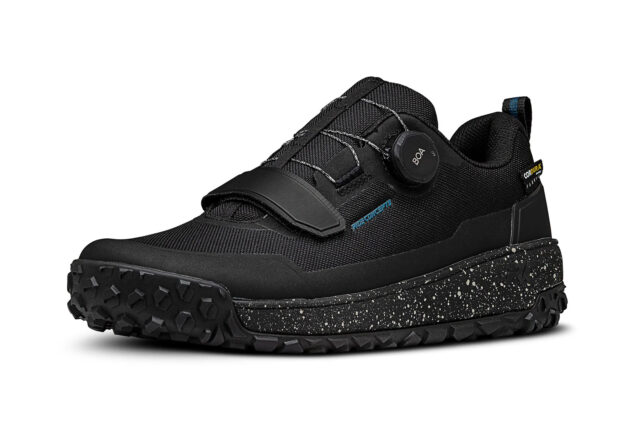
Intro
In the world of bike shoes, it seems as though the flat-pedal category tends to get overshadowed by its clipless counterpart, particularly when it comes to the newest tech and materials. Some modern clipless shoes look like what I imagine the Jetsons would’ve drawn up, had they been into riding bikes up and down trails, whereas some flat shoes have often reminded me of the super bulky mid-2000s skate shoes I’ve affectionately referred to as Dino-stompers (so I guess with the Jetsons reference, maybe they do share something in common?)
Anyway, the fact of the matter is that flat shoes tend to be a bit simpler than clipless alternatives, and in theory, that makes sense — as a system, flat pedals + flat shoes are simpler, with fewer important parts to integrate.
Still, I know plenty of flat-pedal riders who wish that their shoes would see some trickle-down effects from the often-fancier clipless market. After all, clipless riders aren’t the only people who appreciate a secure and adjustable fit, breathable materials, lighter constructions, and so on. Fortunately, this evolution does seem to be happening.
Ride Concepts’ newest and highest-end flat shoe is evidence of this. The Tallac BOA features a — you guessed it — BOA dial-style closure, as well as a Cordura upper, more complex outsole designed for on- and off-bike grip, and a few other features all meant to maximize performance for those who still wish to not be clipped into their pedals.
All of this sounded super appealing to me, a dedicated flats rider, and I used the Tallac BOA as my primary shoe for much of this season to see where it excelled, where it offers room for improvement, and where it falls into the current flat-shoe market.
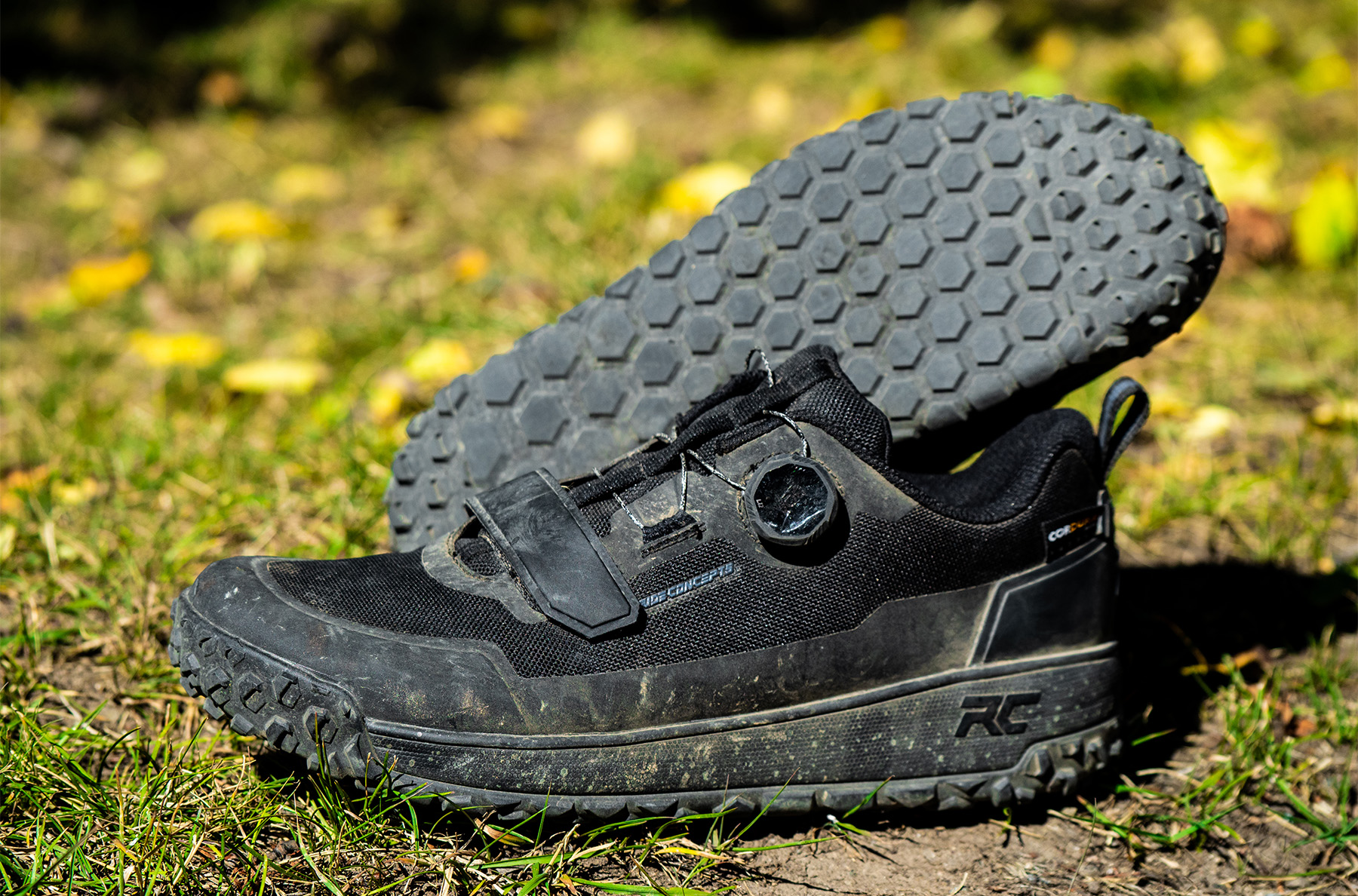
Features & Construction
Starting with the upper, the Tallac BOA already offers a few things rarely seen in its class. The primary material is a pretty rugged Cordura weave, which has so far done a great job of dealing with the occasional encounter with a rock, bush, or other trailside debris. At the same time, this weave is a bit more breathable than the leather or faux-leather materials seen on shoes like the Ride Concepts Powerline and Giro Latch. On the interior, the Tallac BOA uses an anti-bacterial mesh lining; it seems as though my feet can overwhelm any anti-odor treatment, but the Tallac BOA is a bit better than average when it comes to not forcing a gag reflex when I take them off after a long, sweaty ride.
The big story here, so much so that it’s awarded a spot in the shoe’s name, is the Tallac BOA’s closure system. It’s a two-part deal, with a BOA Li2 dial handling the tensioning of the instep and midfoot, and a velcro strap offering additional adjustment near the end of the midfoot / beginning of the forefoot. The BOA dial uses “TX4” laces, which are apparently “strong, flexible, and low friction.”
Overall, I’ve come to love this closure system. That said, it had been a while since I’d used footwear that primarily relied on a BOA closure for foot security, and I soon realized that I should tighten the Tallac BOA’s dial a bit more than I thought I should, in order to achieve a secure fit. My first few rides left me thinking the shoe was a bit too big or loose, but fortunately, the benefit of the BOA Li2 dial is that you can make adjustments — both when tightening and loosening — on the go with ease. A few rides in, I was able to arrive at a very secure, but comfortable fit.
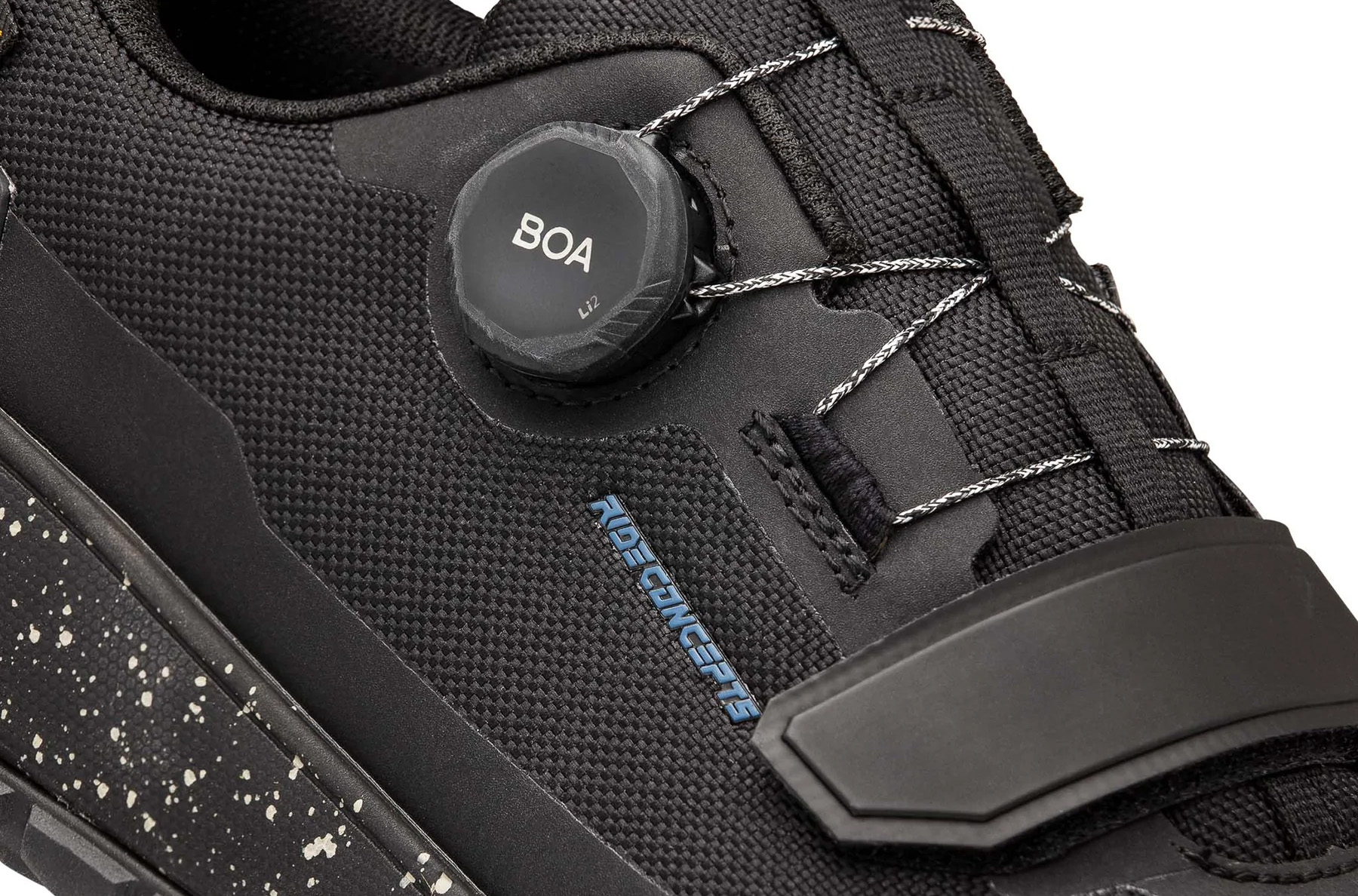
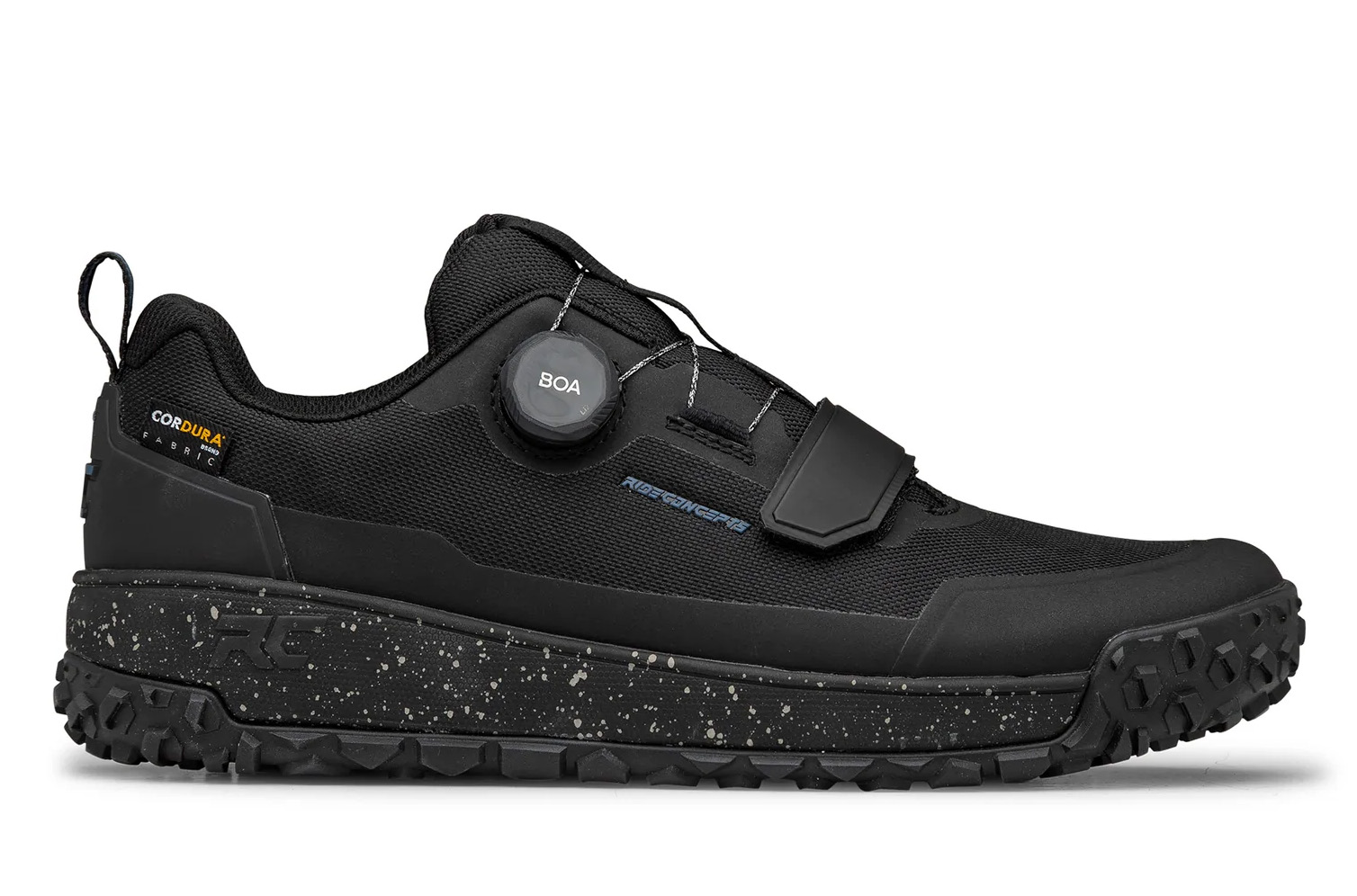
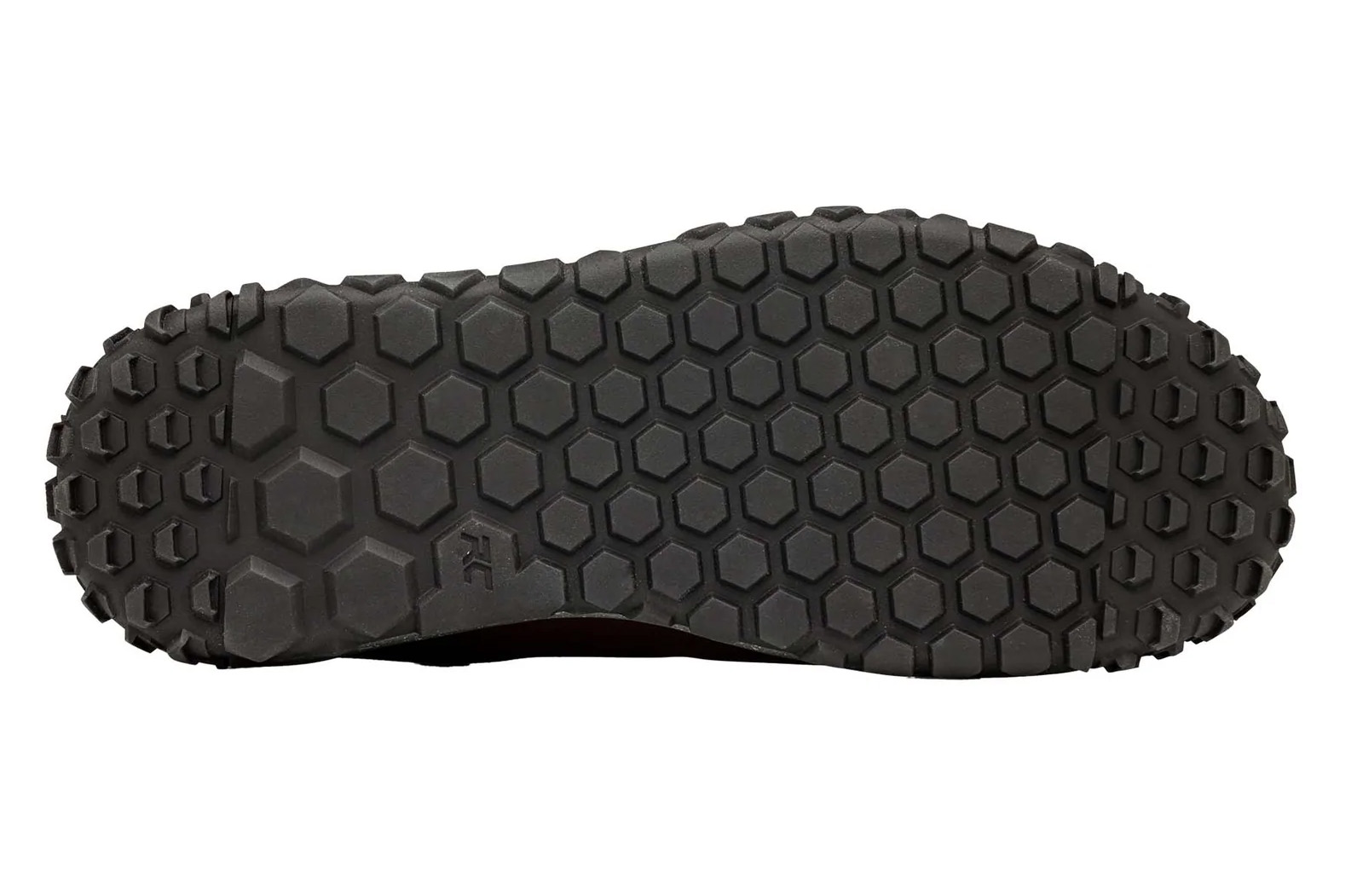
While I have a fairly wide midfoot, my toes also taper a lot from the big one to my pinky, so I don’t often need a big toe box; correspondingly, I didn’t feel as though the Tallac BOA’s forefoot velcro strap was doing a whole lot for me, but it also never presented any issues. I mostly just kept it snug without taking up any extra tension (after tightening down the BOA dial).
Complementing the BOA dial and strap is a gusseted tongue, which helps keep debris from getting inside the Tallac BOA’s upper, and generally aids its fit security.
Other notable upper details include TPU overlays above the midsole and toe bumper, to add a bit of water and abrasion resistance. There’s also a reinforced heel counter, which isn’t super stiff, but does add some appreciable structure to the heel pocket.
Working down to the midsole, the Tallac BOA features a fairly thick block of EVA foam, which is wrapped by a new outsole pattern.
The Tallac BOA’s outsole features hexagonal blocks of varying sizes and implementations. Around the middle, the hexagons look like what we’ve come to expect of Ride Concepts — moderate in size, with the main goal of optimizing on-pedal traction. Moving back to the heel, there’s a small section of bigger hexagons, but the big difference is seen at the toe and heel; the areas you’re most often using for off-bike walking feature a recessed tread that does a much better job of digging into dirt, loam, sand, mud, and other semi-loose surfaces than most flat-pedal-shoe soles. The entirety of the Tallac BOA’s outsole uses Ride Concepts’ tackiest MAX GRIP rubber compound (formerly labeled as Rubber Kinetics DST 4.0).
Lastly, like many Ride Concepts shoes, the Tallac BOA comes with a stock insole that features D30 material (the orange stuff you often see in knee pads, among other body armor), which is meant to absorb impacts and vibrations.
[A note on available models: Ride Concepts also offers a standard-lace version of this shoe without a BOA dial or velcro strap, simply dubbed the Tallac. Then they also make the corresponding women-specific Flume and Flume BOA, which are identical in features but offered in different sizes and colors. Clipless versions of all those shoes are also available; the main difference is that the non-BOA Tallac Clip and Flume Clip do add a velcro instep strap to their standard laces.]
Fit
As always, the only way to really know how well the Tallac BOA works for your feet is to try it on. With that said, I can talk a bit about how it works for my feet (low-volume ankle and instep, wide-ish midfoot, fairly low-volume forefoot).
Ride Concepts says that the Tallac’s fit is “low-volume,” and that it features their “Men’s Performance” fit, which they say offers “optimized padding, stiffer flex, and wider toe box.”
Overall, that seems pretty fair, though I wouldn’t call the Tallac BOA super low volume overall. While I will get a bit of pain at the widest point of my midfoot after a long day in the Tallac BOA, it’s by no means out of the ordinary in that regard (whereas I’ve tried certain “low-volume” shoes that feel unbearable to me in that area after even an hour).
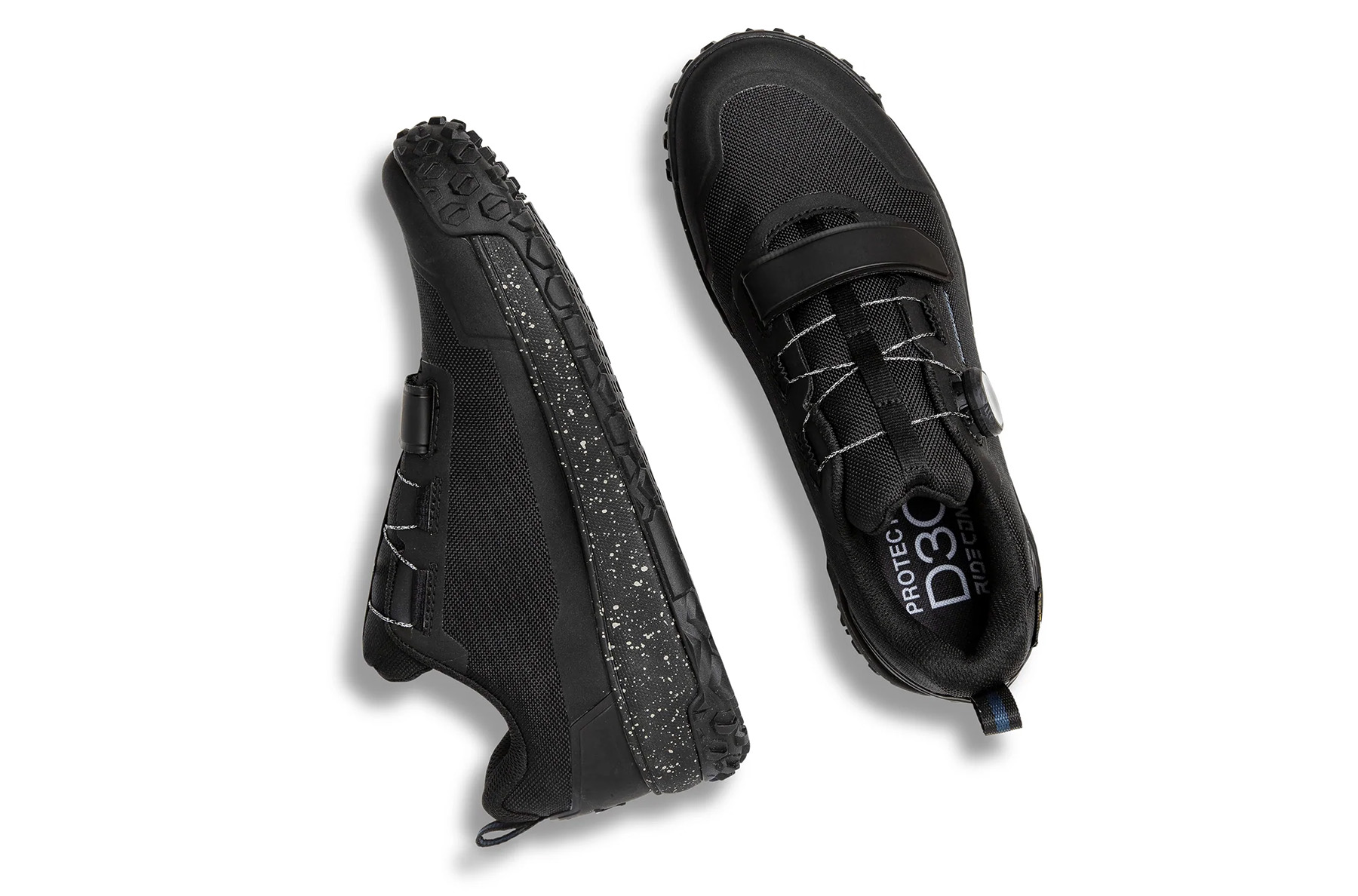
I’ve spent a lot of time in the Ride Concepts Powerline, which the brand labels as having a “high volume” but still “performance” fit. Compared to the Powerline, the Tallac feels a bit narrower, but pretty similar overall. Frankly, the main thing that stood out to me between the two, in terms of fit, was that the Tallac BOA felt a bit longer through the toe box. Even more interesting is that our reviewer, Kara Williard, thought the women’s equivalent to the Tallac, the Flume, ran quite short; I thought the Tallac BOA felt pretty true to size. If you’ve got a really narrow foot, I doubt it’s going to be ultra-snug, but I also wouldn’t hesitate to try it on if you’re initially worried about its “low volume” labeling.
On the Bike
For reference, on-pedal performance is my main priority when it comes to shoes, and Ride Concepts’ shoes have recently been my favorite in that regard. This is highly subjective, but for my preferences, the pedals I’ve used, and the trails I ride, I’ve really enjoyed Ride Concepts’ MAX GRIP outsoles’ combination of traction and adjustability. While I love many Five Ten shoes because of just how well they stay stuck onto pedals, I also find myself wishing they were a bit easier to move around on the pedals when my foot positioning isn’t ideal, particularly with pedals that inherently offer lots of grip.
Given that, I had high hopes for the Tallac BOA, and it has not disappointed. Like the Ride Concepts Powerline, which uses the same MAX GRIP rubber compound but with a different tread pattern, the Tallac BOA does a great job of keeping my feet connected to the pedals while still giving me the option of adjusting them on the fly. The Tallac BOA does not feel quite as stuck-on as some of Five Ten’s grippest shoes (namely, anything with Stealth S1or Mi6 rubber), but it’s not far off, and offers easier foot-adjustment options. And to be clear: while I care about ease of foot adjustments, my main priority is still security on the pedals, and the Tallac BOA still checks that box for me; it’s not some sketchy shoe that flies off my pedal pins as soon as I hit a few roots or rocks.
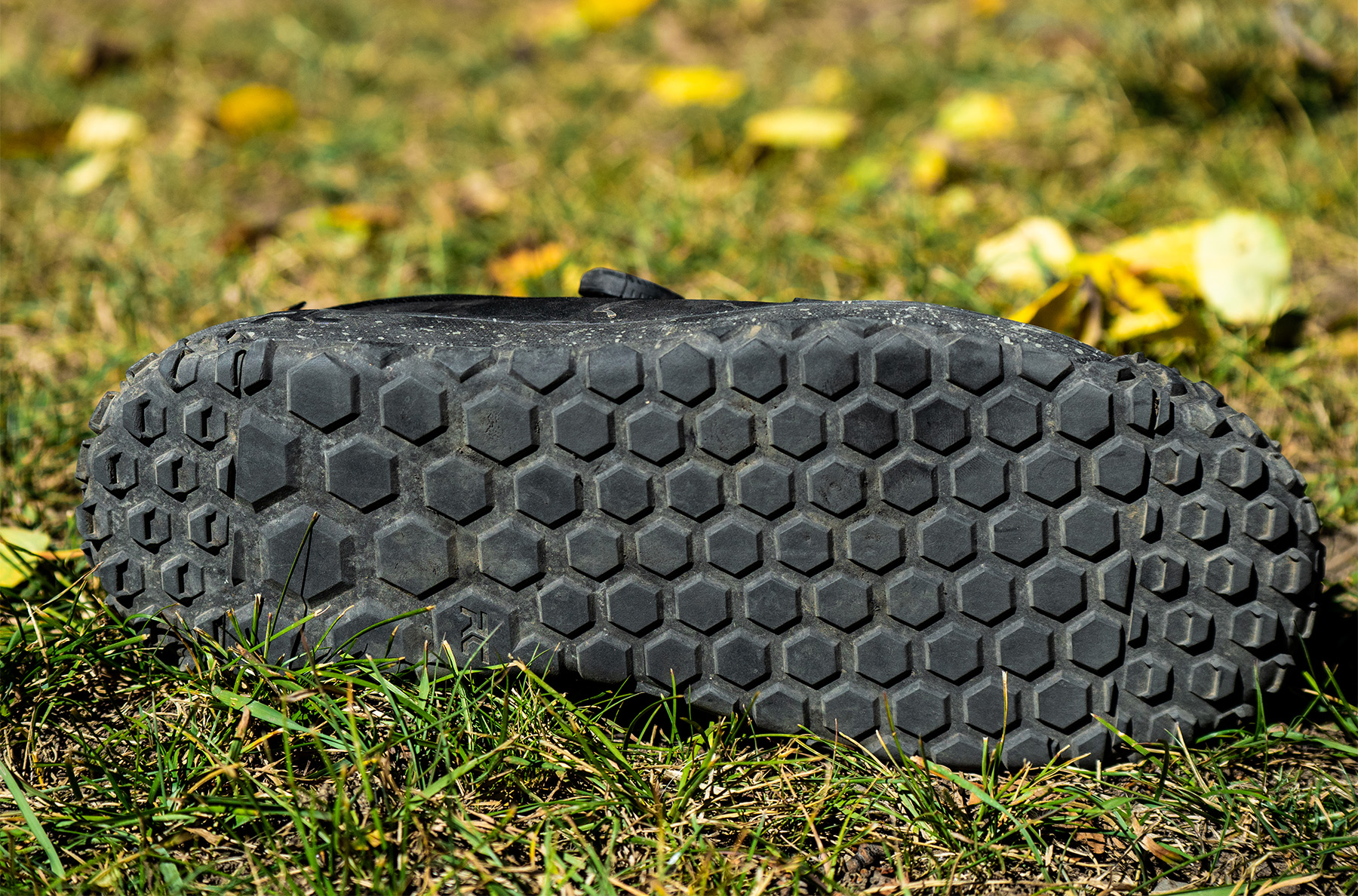
As far as stiffness and efficiency go, I think the Tallac BOA falls slightly on the stiffer end for a flat-pedal shoe. It’s still a lot nicer to walk around in than just about any clipless shoes, but it’s not quite as flexible as the Five Ten Freerider or Giro Latch. I think it feels pretty similar to the Ride Concepts Powerline in this regard, and I’ve had no qualms about using the Tallac BOA for my longer rides (i.e., no issues with foot fatigue). The Tallac BOA is not the most sensitive shoe, but that’s one category with plenty of alternative shoes for flat-pedal riders.
I would be curious to know what the Tallac BOA’s heel-to-toe drop is, since it feels a bit higher than most flat-pedal shoes I’ve used (most of which feel, well, “flat”). I got used to this pretty quickly, but along with its fairly stiff midsole, I think that detracts a bit from how sensitive and connected it feels to the pedals.
Same as the Powerline, the Tallac BOA’s D30 insole does a nice job of muting out some vibrations and impacts, with an overall ride quality that feels fairly damped / calm. While some other Ride Concepts shoes also feature D30 material on the lateral area of the heel (along with a raised heel collar there), to protect from bumps against your bike frame and cranks, the Tallac has a more standard-height, symmetrical heel pocket. This hasn’t been an issue for me so far, but it’s worth noting that the Tallac isn’t the most protective flat-pedal shoe out there.
Off the Bike
With my feet on the pedals, I can’t say I have a big preference between the Ride Concepts Powerline and Tallac BOA — I really like both of them. However, once walking becomes the better option than pedaling, the Tallac BOA really starts to shine. It’s not like it’s a climbing approach shoe or anything, but compared to any flat-pedal shoe I’ve used that offers similar on-pedal traction, the Tallac BOA is notably better when it comes to off-bike performance. Its recessed toe and heel tread do a much better job of digging into looser ground surfaces than most shoe’s outsoles, but its more standard tread underfoot maintains solid on-pedal grip.
And while I appreciate the Tallac BOA’s moderately stiff midsole during long days of pedaling, it’s still pretty comfy to walk around in. No, it doesn’t feel like a climbing shoe, or even a soft hiking shoe. But as far as bike shoes go, I didn’t feel as though the Tallac BOA was a big hindrance during longer hike-a-bikes or a bit of scrambling up short sections of technical trails.
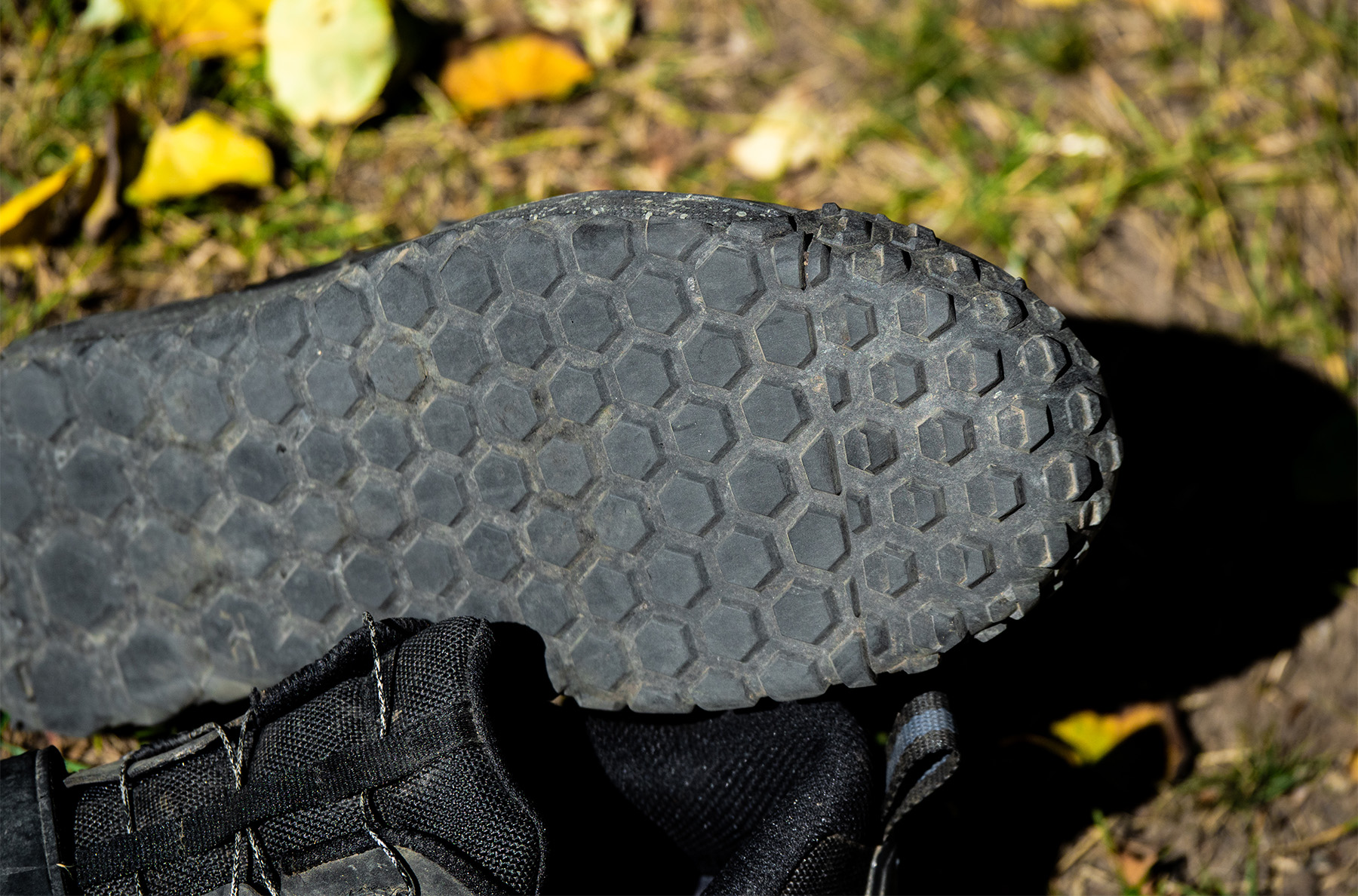
I think the one caveat here is that, if most of your off-bike excursions involve clean, fairly grippy rocks with minimal loose detritus atop them, a flatter-soled shoe with ultra-grippy rubber might be better. Five Ten’s Freerider Pro is a shoe I’d prefer to use for scrambling up steep rock faces, while the Tallac BOA is what I’d pick for pretty much any other scenario, including rock that is covered by a bit of dirt, sand, dust, etc.
Traction aside, I think Ride Concepts have struck a really nice balance with the Tallac BOA when it comes to the other scenarios and elements with which a shoe has to deal. This shoe has held up well to various scrapes and impacts from rocks, roots, bushes, branches, and the like, but it still breathes and dries respectably well, given that. Shoes like the Ride Concepts Powerline and Giro Latch are a bit better when it comes to keeping out minor moisture like dew-covered trailside flora, while the Tallac BOA is notably quicker to dry than both of them, and breathes better on hot, dry days. I only have limited experience with the Five Ten Freerider Pro, but I’d say the Tallac BOA is a bit more breathable and quicker to dry, while maybe not being quite as water resistant.
[David Golay: I’ve only used the standard (non-BOA) Tallac Clip, but it uses the same upper construction as the Tallac BOA and that assessment sounds right to me, especially if we’re talking about the standard synthetic leather version of the Freerider Pro; the Freerider Pro Primeblue is more similar to the Tallac in terms of breathability and water resistance.]
Durability
Overall, the Tallac BOA is holding up really well after a few months of near-daily use. Apart from a few small spots on its outsole (and after a quick spray with a hose), my pair looks almost new.
The Tallac BOA’s outsole has been worn down a tiny bit where the pedals’ pins dig into it, but notably less so than the few grippier options out there (from what I’ve used, that just includes Five Ten’s Freerider series). I’d say the Tallac BOA’s outsole is holding up as well, if not better than the Giro Latch’s rubber, which is the closest comparison I can think of in terms of on-pedal grip.
Given that I’ve been able to get multiple seasons out of Ride Concepts’ Powerline, which uses the same rubber compound, I’d expect the Tallac BOA to hold up to a similar amount of abuse (and this is another benefit relative to the softer, grippier Five Ten Stealth rubber). That said, the Tallac BOA’s tread at the toe and heel does feature some fairly thin lugs, so I’m curious to see how those hold up and resist tearing (like some trail running shoes with thin, soft lugs are prone to do over time).
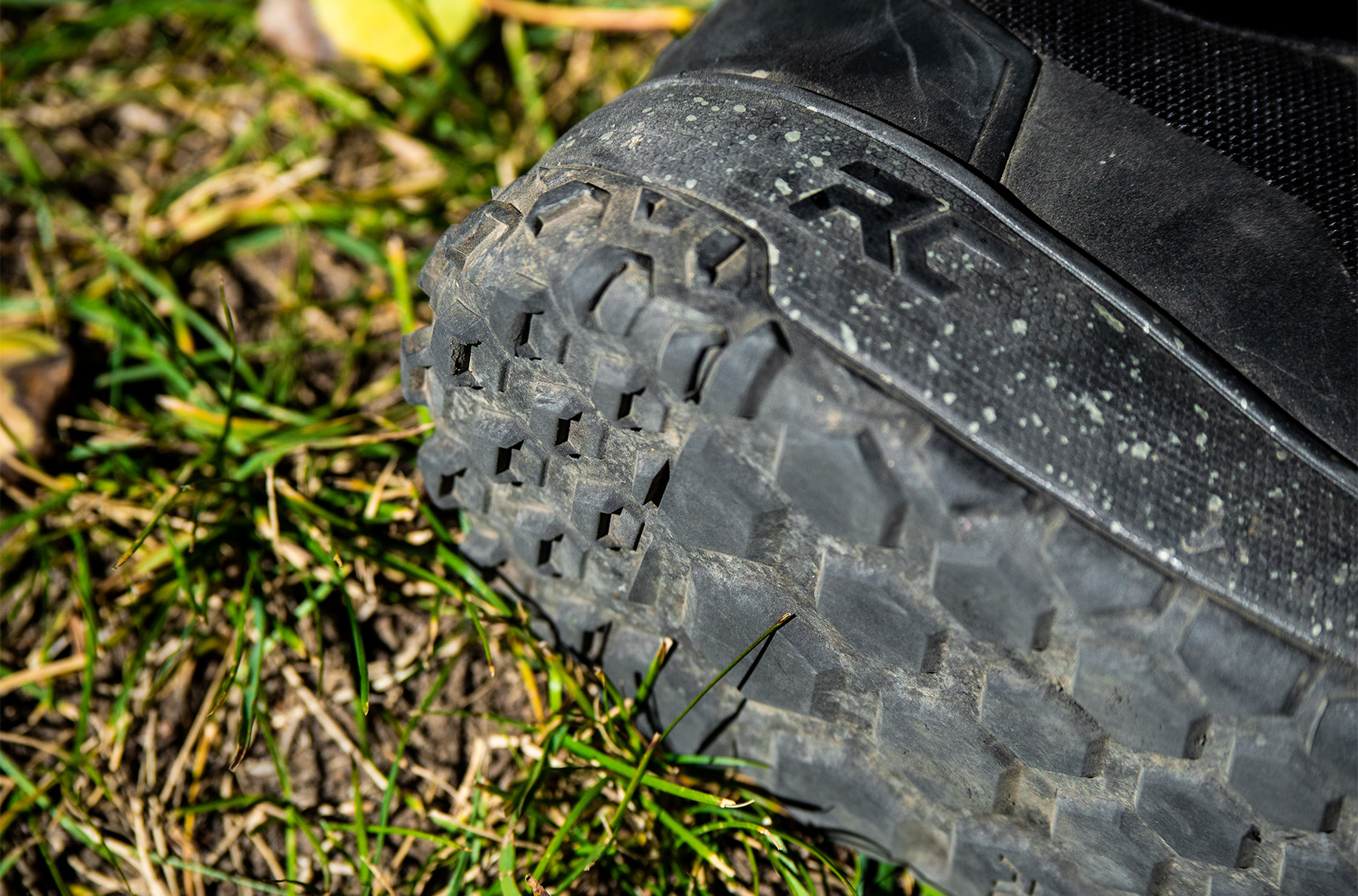
Moving past the outsole, the Tallac BOA is functioning just as well as when I first got it. Its upper has yet to be torn, nicked, or shredded; the BOA dial and velcro strap are functioning perfectly; and I haven’t noticed any packing out of its EVA midsole. The historical worry with BOA dials has been that they’re more complex than laces and more difficult to repair / replace if they break. That’s totally valid, but it’s worth noting that BOA offers a lifetime warranty for their dials and laces, so unless you manage to rip the dial out of the Tallac BOA’s upper, you should be able to replace it for free if it gets damaged.
I’ve been impressed by the longevity of other Ride Concepts shoes I’ve used, and so far, it seems as though the Tallac BOA will continue this trend. As always, I’ll update this if I run into any unusual issues down the line.
Bottom Line
The Ride Concepts Tallac BOA brings some higher-end features to a flat-pedal design, a combination that’s unfortunately still pretty rare, but in this case, it’s executed in a cohesive and useful manner.
One of the draws of flat pedals and their related shoes is simplicity (and affordability), and the Tallac BOA does stray from this to a degree. Its BOA fit system, multi-faceted outsole, versatile upper, medium-volume fit, and moderate midsole all add up to a shoe that feels very capable on and off the bike, but there are alternatives that are grippier on the pedals, more flexible with your feet on the ground, and/or less expensive. However, if you prioritize on- and off-bike performance, appreciate the ability to fine-tune fit on the go, and want a shoe that’s both pretty protective and fairly breathable, you should go try on the Tallac BOA.
